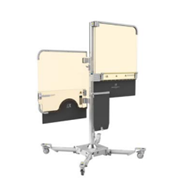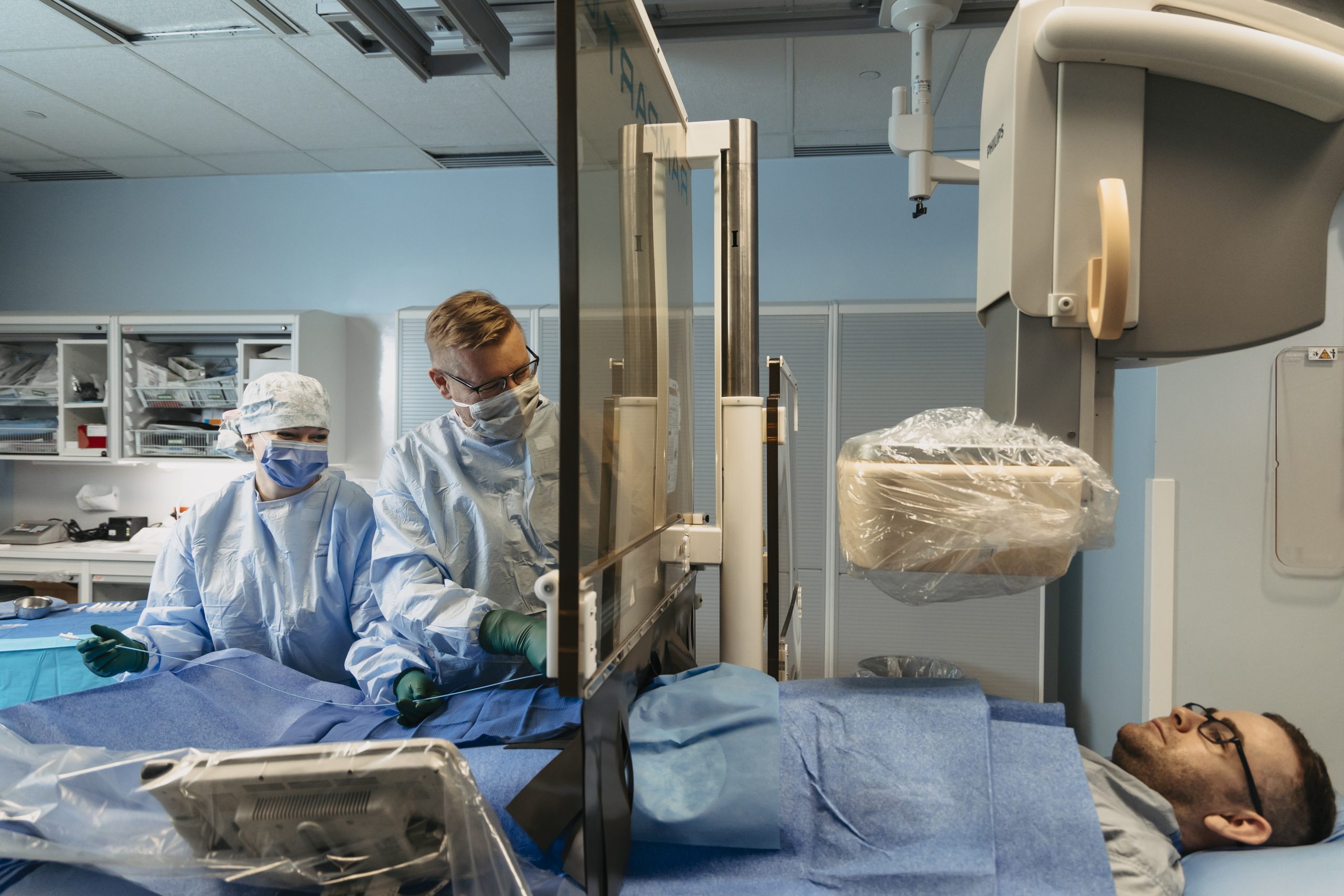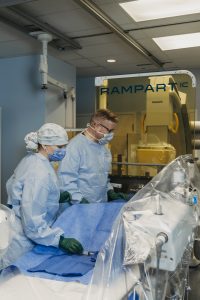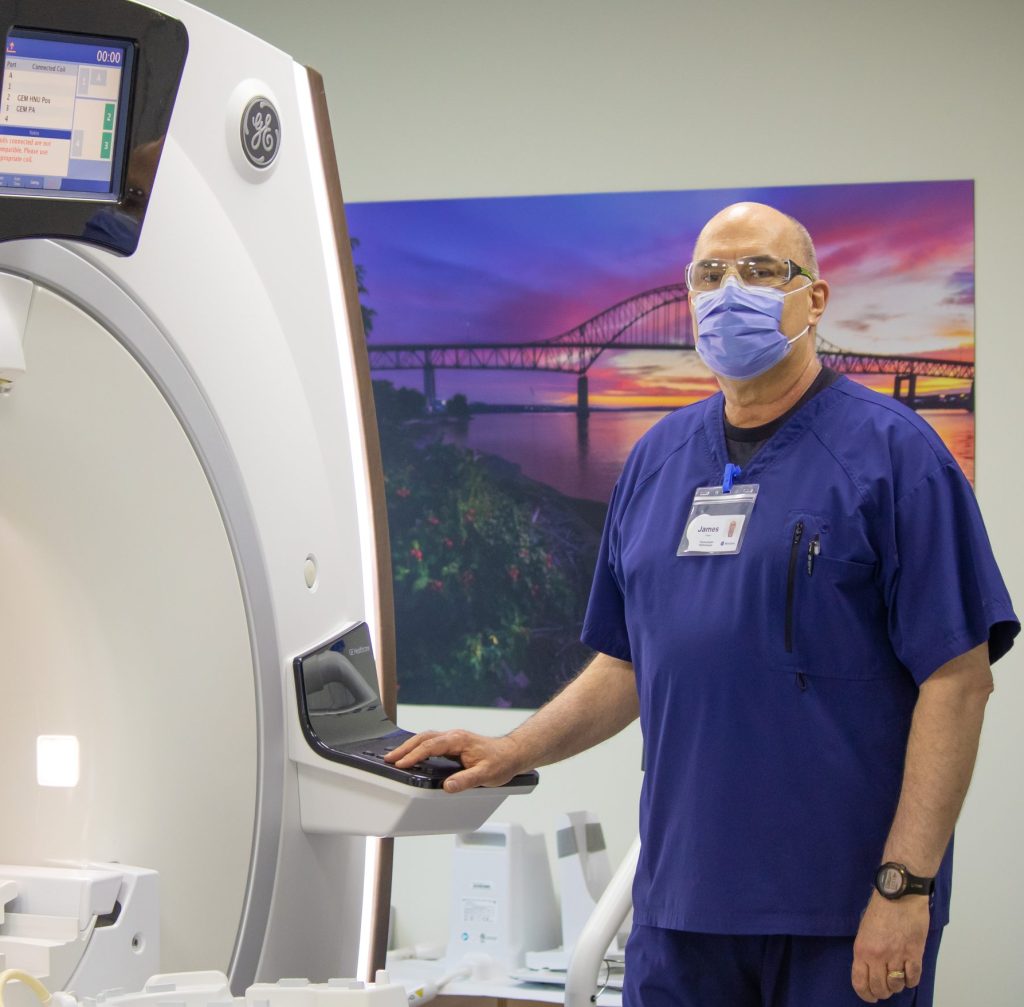News & stories, NB Heart Centre 2nd in Canada to Reduce Radiation Exposure with Rampart Device
February 2024
Donor generosity helps ‘take the weight off’ by allowing Cath Lab staff to work without heavy lead aprons
It may surprise you that the NB Heart Centre’s interventional cardiology team wears 30 lb lead weights under their surgical gowns.
X-rays are essential for guiding the catheters and wires inserted into the patient's blood vessels and heart. To minimize their exposure to radiation, the staff wear heavy lead aprons that block the X-ray beams from reaching their body.
However, as you can imagine, carrying 30 extra pounds for long hours can also negatively affect the staff's well-being. Lead is a very dense metal. The aprons are heavy and uncomfortable. They can cause back pain, neck strain, muscle fatigue, posture problems and long-term orthopedic injuries, especially if staff have to bend or twist while performing complex procedures.
Thankfully, generous people like you have lifted a huge weight from our Cath Lab’s shoulders by helping to purchase a state-of-the-art device that enhances patient safety and staff comfort. The device, called Rampart, is a radiation protection system. It means staff can shed the lead and say goodbye to those heavy lead aprons. Only two hospitals in Canada currently use Rampart — and thanks to our generous community, we are one of them!
 What is Rampart, and how does it help patients and medical staff?
What is Rampart, and how does it help patients and medical staff?
Rampart consists of a shield that can be positioned between the patient and the staff. The shield blocks 95% of the scattered radiation that would otherwise reach the staff. Unlike the lead vests, which only protect the torso, Rampart reduces radiation exposure to the entire body, including the head, eyes, neck, arms, and legs.
The NB Heart Centre: a hub of innovation
At the New Brunswick (NB) Heart Centre, patients from New Brunswick and Prince Edward Island are treated for several heart-related issues.

“The bulk of what most cardiac Cath Labs do across the country and really around the world is coronary intervention,” says Dr. Brent McGrath, Interventional Cardiologist with NB Heart Centre.
“They’re rushed to the hospital, likely due to a plugged artery. We go in and open that artery and often those folks end up with stents. That is certainly the bread and butter of any modern-day Cath Lab.”
But the NB Heart Centre punches above its weight with other procedures as well.
“Most well-known one is an aortic valve replacement. Some patients require open heart surgery for this, but with the evolution we’ve seen over the past several years, we can offer some of those patients a minimally invasive alternative.”
Dr. McGrath explains that in some cases, they go through a puncture, no open chest, and put the valve in – a surgery that is completed in about an hour.
“And the patient is discharged typically next day, so less time in hospital.”
However, this type of elevated care can come at a cost. The team, which includes an Interventional Cardiologist like Dr. McGrath, as well as a nurse and an x-ray technician, need to be in the room to assist.
“Patients are getting sicker, and the cases are longer, so the physical toll of wearing 30 pounds of lead for an hour, let alone sometimes three to four hours plus, is huge,” says Courtney Oram, Manager of the Cath lab.
Exploring alternatives to protect from radiation exposure
“Almost a year ago I was at a meeting with other Interventional Cardiologist’s and was in a presentation on the latest innovations around interventional cardiology. “
Dr. McGrath was intrigued when his colleague started to talk about Rampart, and how their institution had now been working lead free while reducing exposure to radiation.
“So we brought it up here, and because we’re a small, nimble shop we could put resources behind getting the information that the Foundation needed to help us make it happen.”
Rampart protects from exposure, can ‘take the weight off’ for surgical teams
For Brittany Cheney, a registered nurse for the Cath lab, the Rampart is more than a shield.
“Not having the consequences of sore neck, sore backs, you know, worrying about your eyesight, things like the worry that you have in the back of your head by being around that much radiation throughout your career – it’s a relief.”
That relief is because of the important role that radiation plays when it comes to the surgeries that are performed.
Without radiation, the procedure couldn't happen" says Amy Allard, medical radiation technologist for the Cath lab.
I can tell you, having worked in some large centers…we offer everything and more that needs to be offered here in New Brunswick and it's the support of donors of the foundation that make that possible."
- Dr. Brent McGrath, Interventional Cardiologist
Some of the key benefits of Rampart include:
 Eliminates the need for heavy lead aprons for the physician and team
Eliminates the need for heavy lead aprons for the physician and team- Full-body radiation coverage when combined with the use of under table radiation protection
- Radiation protection extends from the right of the operator to the foot of the table
- Allows for longer and more complex procedures
- Increases potential for longer careers with the elimination of the apron
- Potential for fewer workdays missed and worker’s comp claims filed
- Does not isolate the physician from their team or limit mobility
Along with the overall protection, Courtney and her colleagues see the long-term impacts of having the Rampart in the Cath lab.
“With rampart, we're hoping that we're moving towards a leadless future, so that the physicians, the nurses, and x-ray techs can work here longer and be more experienced, trained healthcare professionals to provide the best patient care.”
Brittany added, “Like Courtney said, if we can keep our staff from being injured and offer a safer workplace, that will be able to keep the longer term. Plus, the Rampart also protects the entire body, not just the torso like the lead aprons do. So it's really good.”
Not possible without the generosity of donors
Along with the overall protection, Courtney and her colleagues see the long-term impacts of having the Rampart in the Cath lab.
“With rampart, we're hoping that we're moving towards a leadless future, so that the physicians, the nurses, and x-ray techs can work here longer and be more experienced, trained healthcare professionals to provide the best patient care.”
Brittany added, “Like Courtney said, if we can keep our staff from being injured and offer a safer workplace, that will be able to keep the longer term. Plus, the Rampart also protects the entire body, not just the torso like the lead aprons do. So it's really good.”


